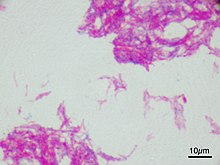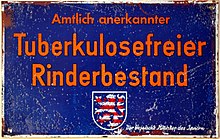Bovine tuberculosis
The tuberculosis in cattle (obsolete Perlsucht ) is a by Mycobacterium bovis caused infectious disease of cattle . It can be transferred to humans and is therefore a zoonosis ; In practice, humans are usually infected through the consumption of raw milk from infected cattle herds.
Compared with Mycobacterium tuberculosis , the main causative agent of tuberculosis in humans , cattle are also susceptible, but such infections are very rare. Tuberculosis in cattle manifests itself primarily in the lungs , and in calves in the throat and intestines . In Germany it is a notifiable animal disease and its control is regulated by law. There is a cure and vaccination ban. Notification is also required in Austria. Due to the control measures, the disease is now very rare in Europe.
Pathogen and disease development
The causative agent of tuberculosis in cattle is Mycobacterium bovis . Other mycobacteria can infect cattle, but usually do not lead to diseases.
The infection occurs through a droplet infection or ingestion of contaminated drinking water or food. The main sources of new diseases in cattle in Western Europe and North America today are mainly elderly people who are still infected with M. bovis , or zoo animals, in which the pathogen is also still common. In the United Kingdom and New Zealand, contagion from wild animals such as badgers and foxes also play a greater role.
Cattle tuberculosis typically has four stages:
- In the first stage developed at the portal of entry and regionären lymph nodes an inflammation , the so-called primary complex . In animals with a strong immune system , the disease can end here or at least a longer relative immunity can set in. At this stage there is an increased reaction to mycobacteria, which was previously used diagnostically in routine tuberculin tests .
- In the second (subprimary) stage , with a reduced immune system, the pathogen spreads via the blood ( bacteremia ) and colonizes internal organs. This leads to the development of small nodules, which can either be massive ( acute miliary tuberculosis ) or be restricted to individual foci. Clinical healing is also possible in the second stage.
- The third stage (post-primary tuberculosis) arises from endogenous reactivation or superinfection and leads to isolated chronic organ tuberculosis . It spreads primarily along anatomical structures such as the bronchi. The lymph nodes are not changed at this stage.
- The fourth stage (anergy or breakdown phase) is characterized by spreading to many organs (late generalization) with involvement of the lymph nodes.
Clinical picture and diagnostics
The clinical picture of tuberculosis in cattle is extremely variable and also depends on the organs affected. In calves, the throat and intestines are particularly affected and there are hardly any clinical symptoms. In adult cattle, the lungs are mostly affected. The clinical symptoms are unspecific and consist of decreased performance, emaciation, fever attacks and a dull cough.
The diagnosis cannot be made clinically. By abolishing the regular tuberculin tests, the disease will only be recognized during slaughter as part of the legally prescribed meat inspection.
Combat
In Germany, control is regulated by the Ordinance on Protection against Tuberculosis in Cattle ( Tuberculosis Ordinance ). Any kind of treatment and vaccination are prohibited in order to prevent infected but not sick animals from spreading the disease further undetected. According to the ordinance on notifiable animal diseases (TierSeuchAnzV), there is an obligation to notify cattle tuberculosis caused by Mycobacterium bovis and Mycobacterium caprae in Germany . In Austria, too, there is an obligation to notify, in Switzerland the disease is one of the "epidemics to be eradicated" ( group 2 animal diseases ).
The pasteurization of the milk kills the pathogen so that it is no longer possible to infect humans in this way.
In the British Isles, badgers are the main vector of bovine tuberculosis. Between 1986 and 2009 there was a significant increase in bovine tuberculosis cases, particularly in western England and south Wales. In England, a program was therefore started in June 2013 to reduce the roof population through targeted hunting, which was met with protests from animal rights activists. Attempts are being made to vaccinate badgers in Wales while Scotland is bovine tuberculosis free.
See also: Emergency slaughter in New Zealand 2017/18
history

Bovine tuberculosis is a long-known disease. The first description can be found in Columella from the year 40 AD. Despite its frequent occurrence, it was not associated with human tuberculosis, but rather as "pearl addiction" assigned to syphilis . In 1797, the Braunschweig doctor Klencke suspected a connection between the consumption of cow's milk and human tuberculosis. The parallels between pearl sickness and consumption, and thus the assignment to tuberculosis, did not occur until the middle of the 19th century. The famous pathologist Rudolf Virchow thought the TB herd in cattle was sarcoma .
In 1868 Villemin demonstrated that cattle tuberculosis is an infectious disease that can be transmitted from cattle to humans and vice versa. With the discovery of mycobacteria, Robert Koch was able to underpin this discovery aetiologically. Koch and Emil Adolf von Behring , however, were of the opinion for a long time that bovine tuberculosis was not transferable to humans, since the pathogen is not the human tuberculosis pathogen Mycobacterium tuberculosis . The experimental work of the French microbiologist Saturnin Arloing , however, clearly demonstrated the zoonotic character of bovine tuberculosis up to 1908 . Arloing had already obtained a ban on the import of tuberculous cattle into France in 1872 and had started a government program to combat the disease.
Tuberculosis in cattle was a very common infectious disease up to the middle of the 20th century and also posed a serious infection threat to humans. A study of half a million cattle in 1936 showed a morbidity of 31.3% in Germany , with almost two thirds of the stocks were affected.
In 1952 a voluntary control procedure with tuberculin tests and premiums for milk tuberculosis-free stocks was started in the FRG. In 1955 a similar program started in the German Democratic Republic , which was converted into a mandatory procedure in 1959. As early as 1961, 99.7% of all farms in the FRG were state-approved tuberculosis-free. In the GDR in 1967 77% and in 1971 99% of the stocks were free of tuberculosis. In view of the extensive freedom in Germany, the three-year tuberculin tests were abolished in 1997.
Individual evidence
- ↑ Annex to Section 1 of the Ordinance on Notifiable Animal Diseases (TKrMeldpflV) in the version published on February 11, 2011 ( Federal Law Gazette I p. 252 ), last amended by Article 381 of the Ordinance of August 31, 2015 ( Federal Law Gazette I p. 1474 )
- ↑ Ways of infection for tuberculosis on tuberkulose-ratgeber.de, accessed on January 30, 2013.
- ^ Bovine Tuberculosis Eradication Program. (PDF; 1.3 MB) July 2011, accessed on June 1, 2013 (English, p. 12/13).
- ↑ Badger cull given go ahead in two test areas. BBC News, May 31, 2013, accessed June 1, 2013 .
- ^ Debate on bovine TB. BBC News, January 29, 2013, accessed June 1, 2013 (Speech by Welsh Minister John Griffiths at the National Assembly for Wales ).
- ↑ Scotland's TB-free status 'not threatened by outbreak'. (No longer available online.) Farmers Weekly, April 13, 2012, archived from the original on April 20, 2012 ; accessed on July 1, 2013 . Info: The archive link was inserted automatically and has not yet been checked. Please check the original and archive link according to the instructions and then remove this notice.
- ↑ a b c d D. Matthias: Tuberculosis of cattle (Mycobacterium bovis infection). In: J. Beer: Infectious diseases of domestic animals . 2nd Edition. Fischer-Verlag, Jena 1980, pp. 626-638.
- ^ Courmont, quoted in M. Roussel (1932): Éloge du professeur Arloing. Bull. Acad. vét. Fr.: LXXXV, pp. 429-448.
Web links
- LMU script
- Tuberculosis Regulation
- Tuberculosis - Information from the Federal Food Safety and Veterinary Office


